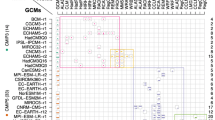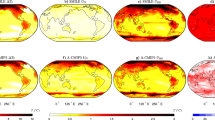Abstract
Communicating information about consistency in projections is crucial to the successful understanding, interpretation and appropriate application of information from climate models about future climate and its uncertainties. However, mapping the consistency of model projections in such a way that this information is communicated clearly remains a challenge that several recently published papers have sought to address in the run up to the IPCC AR5. We highlight that three remaining issues have not been fully addressed by the literature to date. Allen and Ingram (Nature 419:224, 2002) While additional information about regions where projected changes in rainfall are not ‘statistically significant’ can provide useful information for policy, the spatial scale at which changes are assessed has a substantial impact on the signal-to-noise ratio, and thus the detectability of changes. We demonstrate that by spatially smoothing the model projections we can provide more information about the nature of the signal for larger regions of the world. Christensen et al. (2007) Combining information about magnitude, consistency and statistical significance of projected changes in a single map can cause reduced legibility. We demonstrate the difficulty in finding a ‘universal’ method suitable for a wide range of audiences DEFRA (2012) We highlight that regions where projected changes in average rainfall are not statistically significant, changes in variability may still cause significant impacts. We stress the need to communicate this effectively in order to avoid mis-leading users. Finally, we comment on regions of the world where messages for users of climate information about ensemble consistency have changed since AR4, noting that these changes are due largely to changes in the methods of measuring consistency rather than any discernable differences between the CMIP3 and CMIP5 ensembles.




Similar content being viewed by others
References
Allen MR, Ingram WJ (2002) Constraints on future changes in climate and the hydrologic cycle. Nature 419:224
Christensen JH, Hewitson B, Busuioc A, Chen A, Gao X, Held I, Jones R, Kolli RK, Kwon W-T, Laprise R, Magaña Rueda V, Mearns L, Menéndez CG, Räisänen J, Rinke A, Sarr A, Whetton P (2007) Regional climate projections. In: Solomon S, Qin D, Manning M, Chen Z, Marquis M, Averyt KB, Tignor M, Miller HL (eds) Climate change 2007: the physical science basis. Contribution of working group I to the Fourth Assessment Report of the Intergovernmental Panel on Climate Change. Cambridge University Press, Cambridge
DEFRA (2012) The UK climate change risk assessment 2012 evidence report. Accessed 03-01-2013.
Giorgi F, Francisco R (2000) Evaluating uncertainties in the prediction of regional climate change. Geophys Res Lett 27:1295–1298
Hawkins E, Sutton R (2011) The potential to narrow uncertainty in projections of regional precipitation change. Clim Dyn 37:407–418
Hawkins E, Sutton R (2012) Time of emergence of climate signals. Geophysical Research Letters 39.
Held IM, Soden BJ (2006) Robust responses of the hydrological cycle to global warming. J Clim 19:5686–5699
IPCC (2007) Summary for Policymakers. In: Solomon S, Qin D, Manning M, Chen Z, Marquis M, Averyt KB, Tignor M, Miller HL (eds) Climate change 2007: the physical science basis. Contribution of working group I to the Fourth Assessment Report of the Intergovernmental Panel on Climate Change. Cambridge University Press, Cambridge
Kaye NR, Hartley A, Hemming D (2012) Mapping the climate: guidance on appropriate techniques to map climate variables and their uncertainty. Geosci Model Dev 5:245–256
Kendon EJ, Rowell DP, Jones RG, Buonomo E (2008) Robustness of future changes in local precipitation extremes. J Clim 21:4280–4297
Kharin VV, Zwiers FW (2005) Estimating extremes in transient climate change simulations. J Clim 18(8):1156–1173
Knutti R (2010) The end of model democracy? Clim Chang 102:395–404
Masson D, Knutti R (2011) Spatial-scale dependence of climate model performance in the CMIP3 ensemble. J Clim 24:2680–2692
Meehl GA, Arblaster JM et al (2005) “Understanding future patterns of increased precipitation intensity in climate model simulations.” Geophys Res Lett 32(18)
Meehl GA, Covey C, Delworth T, Latif M, McAvaney B, Mitchell JFB, Stouffer RJ, Taylor KE (2007) The WCRP CMIP3 multi-model dataset - a new era in climate change research. Bull Am Meteorol Soc 88:1383
Power SB, Delage F, Colman R, Moise A (2012) Consensus on twenty-first-century rainfall projections in climate models more widespread than previously thought. J Clim 25:3792–3809
Taylor KE, Stouffer RJ, Meehl GA (2012) An overview of CMIP5 and the experiment design. Bull Am Meteorol Soc 93:485–498
Tebaldi C, Arblaster JM, Knutti R (2011) Mapping model agreement on future climate projections. Geophys Res Lett, 38
Wilby RL, Dessai S (2010) Robust adaptation to climate change. Weather 65:180–185
Wilby RL, Fowler HJ (2010) Regional climate downscaling. In: Fung F, Lopez A, New M (eds) Modelling the impact of climate change, chapter 3, 1st edn. Blackwell, Oxford, UK p 34–85
Acknowledgments
This work was supported by the Joint DECC/Defra Met Office Hadley Centre Climate Programme (GA01101). We acknowledge the World Climate Research Programme’s Working Group on Coupled Modelling, which is responsible for CMIP, and we thank the climate modelling groups for producing and making available their model output. For CMIP the U.S. Department of Energy’s Program for Climate Model Diagnosis and Intercomparison provides coordinating support and led development of software infrastructure in partnership with the Global Organization for Earth System Science Portals. We are also grateful to Jamie Kettleborough, Ian Edmond and Emma Hibling at the Met Office Hadley Centre for developing tools which have allowed us to download and access this data easily. We thank Ben Booth for useful comments and encouragement in developing this manuscript.
Author information
Authors and Affiliations
Corresponding author
Rights and permissions
About this article
Cite this article
McSweeney, C.F., Jones, R.G. No consensus on consensus: the challenge of finding a universal approach to measuring and mapping ensemble consistency in GCM projections. Climatic Change 119, 617–629 (2013). https://doi.org/10.1007/s10584-013-0781-9
Received:
Accepted:
Published:
Issue Date:
DOI: https://doi.org/10.1007/s10584-013-0781-9




